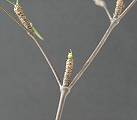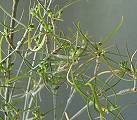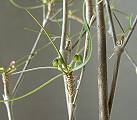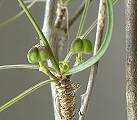|
Giant carrot Euphorbia hedyotoides from Madagascar Slender leafy branches and a
huge carrot root are diagnostic for this species. A further oddity are the
alternately long and short shoots. Only the short shoots develop leaves and
cyathia. |
||
|
The unisexual cyathia are
small and insignificant, but appear in great numbers between March and
November. For pollination and seed production you need a female and a male
plant. Spitefully E.hedyotoides has the habit of changing its sex, usually to
the detriment of its owner. The one who buys a male plant in addition to his
female will often discover that he soon has two males or two females. (Remark) After successful pollination
which is executed by small insects if not by the paint brush of the owner, fruits
are produced fast. The seeds germinate easily and produce, after a slightly
longer germination time (within 1 to 6 weeks), rather slow-growing seedlings. Slow, incidentally, only
above the ground. Below soil level a big tap root is produced very fast,
which in a one-year old seedling can reach 10 to 15 cm in length and the
thickness of a finger. To prevent malformation and distortion of the tap
root, the seeds should be planted far apart and in a deep pot right from the
start. A deep pot is the key to
success with this plant. Choose one which seems to be two or three sizes too
large and too deep! If you have space in the greenhouse, choose a bucket.
More than 90 percent of the plant is below the surface! In cultivation the tap root
is often planted half exposed. That way you can firstly enjoy it, and
secondly alleviate the rot problem. E.hedyotoides is not particularly
sensitive, but the substrate should be well draining to prevent rot. Being Madagascan, Euphorbia
hedyotoides likes it warm in winter (min. 15°C) and slightly damp, just so
the substrate doesn’t dry out completely. The linear, sickle-shaped leaves
are shed in winter. Preferably E.hedyotoides
should be propagated by seed. Rooting of cuttings by the usual method is
difficult, as the thin branches dry out quickly. However I was successful
rooting them in water. After 6 to 8 weeks there were enough roots to pot it
up. By the looks of it, it does form a tuber. Try it, if you enjoy
experimenting!. |
|
|
|
Sources for E. hedyotoides: DE: Kakteen-Haage FR: CB-Succulentes DE: Exotica, Botanische Raritäten US: Aridlands US: Tropiflora |
||
Actually a change of sex in one or the other direction occurs
with the same frequency and independently of the sex of the plant already
present. But people make a difference by acting in one of the following cases.
Case 1: To a present female or male, a partner of the
opposite sex is bought. When after that one of the plants, no matter which one,
changes sex, it is definitely a disappointment for the owner.
Case 2: To an existing female or male, a plant of the same
sex is bought. If now one of the plants changes its sex this happens to the
great joy of the owner, who can now harvest seed.
Despite a sex change occurring in both cases with the same
probability, it seems logical to most people to act according to case 1 (and to
get disappointed).
If you found this page without a left frame
please load www.euphorbia.de




